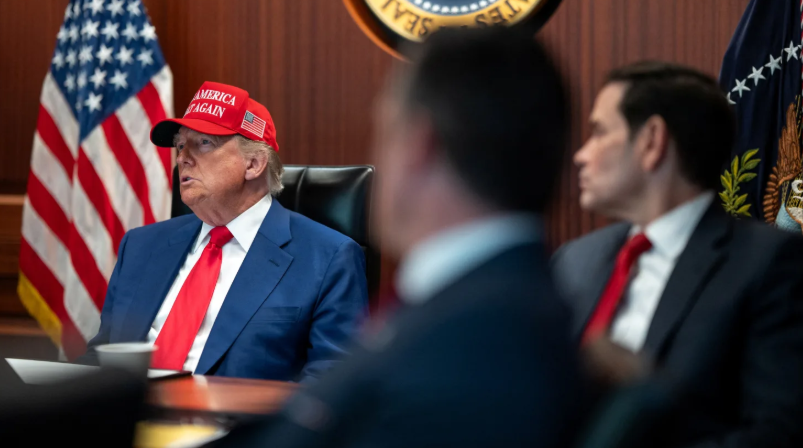Detailing the operation, Trump said the U.S. and Israel, “worked as a team, like perhaps no team has ever worked before. We’ve gone a long way to erasing this horrible threat” to the American ally.
The president congratulated the U.S. military on “an operation the likes of which the world has not seen in many, many decades. Hopefully we will no longer need their services in this capacity.”
“There will be either peace, or there will be tragedy for Iran far greater than we have witnessed over the last eight days. Remember, there are many targets left,” Trump said.
“Tonight was the most difficult of them all by far, and perhaps the most lethal. But if peace does not come quickly, we will go after those other targets with precision, speed and skill, most of them can be taken out in a matter of minutes,” he added.
Trump watched the strikes unfold Saturday from the White House Situation Room, where he was joined by his national security team and closest aides.
The president initially announced the strikes on social media Saturday, where he wrote that “a full payload of BOMBS was dropped on the primary site, Fordow.”
It was unclear late Saturday precisely how much damage the U.S. strikes had done to the heavily fortified Iranian nuclear sites, or whether any American military assets were still active in the country.
Earlier in the day, several U.S. Air Force B-2 stealth bombers reportedly left Missouri, heading west over the Pacific Ocean. The massive planes are some of the only U.S. aircraft capable of carrying the GBU-57 Massive Ordnance Penetrator (MOP), a 30,000-pound bomb known as the “bunker buster.”
The bunker buster bombs are widely viewed as the only conventional, non-nuclear weapons capable of inflicting serious damage on the Fordo nuclear facility, which is built into the side of a mountain.
As of Sunday morning in London, the International Atomic Energy Agency said “no increase in off-site radiation levels has been reported as of this time” at the three nuclear sites following the U.S. incursion. IAEA chief Rafael Grossi convened an emergency meeting of the agency board governors on Monday.
The head of Iran’s Nuclear Safety Center said no radiation contamination or nuclear radiation has been observed at the sites following the attack, according to Google-translated comments carried by Iran’s Fars news agency.
Saturday’s action puts the United States in direct armed conflict with Iran, a massive escalation in its involvement with Israel’s effort to cripple Tehran’s nuclear program and topple its regime.
Trump spoke with Israeli Prime Minister Benjamin Netanyahu after the U.S. strikes, the Israeli leader said.
“I congratulated him, the United States pilots, and the American people. President Trump is a strong leader of the free world. He is a great friend of Israel, a friend like no other,” Netanyahu said of the call in a Google-translated social media post. “In my name and on behalf of all the citizens of Israel, on behalf of the entire Jewish people, I thank him from the bottom of my heart.”
The decision to attack Iran once again engages the American military in active warfare in the Middle East — something Trump had vowed to avoid during his second term in office.
It also marks a major shift from just 48 hours ago, when Trump said the United States would take “two weeks” to see if the conflict between Israel and Iran could be resolved diplomatically.
“Based on the fact that there’s a substantial chance of negotiations that may or may not take place with Iran in the near future, I will make my decision whether or not to go within the next two weeks,” Trump said Thursday in a statement issued by the White House.
Behind the scenes, the Trump administration has been trying to reach a deal with Iran over its nuclear program, and Trump in recent months had reportedly urged Netanyahu to hold off on a strike.


